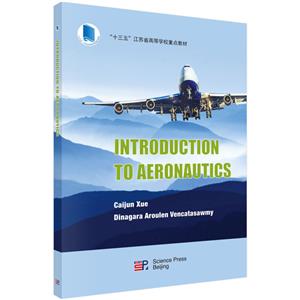-
>
湖南省志(1978-2002)?铁路志
-
>
公路车宝典(ZINN的公路车维修与保养秘籍)
-
>
晶体管电路设计(下)
-
>
基于个性化设计策略的智能交通系统关键技术
-
>
德国克虏伯与晚清火:贸易与仿制模式下的技术转移
-
>
花样百出:贵州少数民族图案填色
-
>
识木:全球220种木材图鉴
航空概论(英文版) 版权信息
- ISBN:9787030698896
- 条形码:9787030698896 ; 978-7-03-069889-6
- 装帧:一般胶版纸
- 册数:暂无
- 重量:暂无
- 所属分类:>
航空概论(英文版) 本书特色
适读人群 :国内几个有航空航天类专业的高校针对来华留学生,我校国内大学生?该书是目前国内唯一一部英文航空概论教材,与国外类似教材相比,章节安排方面更加适应我国高校留学生培养方案。
航空概论(英文版) 内容简介
系统扼要地介绍航空科学技术基础和重要的知识,主要包括6部分内容:航空发展史、空气动力学基础、航空器飞行原理、航空发动机、航空器结构基础、航空仪表及导航等;《航空概论(英文版)》也介绍了航空器一些新的技术进展。
航空概论(英文版) 目录
航空概论(英文版) 节选
Chapter 1 History of Aeronautic 1.1 Evolution from Wheel to Space Most people today have a very little understanding of how traveling was challenging in ancient times and take for granted the very means of travel available to them. One could imagine how different life would be if man had never tamed that first wild horse, or shaped that very first wheel. How did our ancestors think about these life-altering ideas? Where did those instincts come from? How time led humanity from the ground to the stars? The history of aviation has extended over more than two thousand years, from the earliest forms of aviation, kites, and attempts at tower jumping, to supersonic and hypersonic flight by powered heavier-than-air jets. Kite flying in China dates back to several hundred years BC and slowly spread around the world. It is thought to be the earliest example of man-made flight. Some kites in China were capable of carrying a man into the air. The ancient Chinese also invented hot-air lanterns and bamboo-copter toys with spinning rotors. Archaeologists believe that the very first step toward man-made carriage began in either Mesopotamia or Asia, sometime around 4000–3500 BC, with the invention of the wheel. Man had already learned how to train horses by this period, and they were used to till the soil and plant crops. The invention of the wheel eventually created man’s ability to transport his crops from one place to another, where it gave birth to the idea of trade and exchange, and thus leading to the development of bulk transportation. The next evolutionary step of humankind was the invention of the cart. The two-wheeled cart was invented by the Sumerians around 3500 BC and it is believed to be the world’s first form of wheeled carriage. With time, this chariot evolved to the four-wheeled cart, which resolved the issues of carrying supplies and equipment. As man overcame the boundaries of land travel, his curiosity about exploring the world’s frontier became imminent. Even before the taming of the horse, man had already developed a way to travel on water. The dugout boat is one of history’s great mysteries due to its unknown origin. Historians are unable to identify when or where the very first water vessel was set afloat, and even speculate that it might have been purely an accidental creation. Fortunately, the development of the boat led to a change to the phase of transportation due to its ability to allow man to cross continents for the first time ever without the thought of dying. Over time, simple boat also known as a sail consisted of a large piece of cloth mountedon a central pole, transforming the boat into a sail-propelled ship. This new invention contributed to the ability to use rivers and oceans as a means of instant travel from one place to another against the current. Man kept expanding this horizon due to its vast exploitation possibilities and its potential in the future. Ships would eventually take on sleekness as they increased in size. Not long after, ship increased in size where oars, rudders, and deck covers were added. By Greek and Roman times, ships had grown clunky shipboard towers as well, which developed, over time, into the medieval forecastles. By the late medieval era, these castles were built solid as a part of the ship’s basic structure. Then, by the Renaissance and the Age of Exploration which followed, ships had gained tiers of rigging and sails, becoming sleek and speedy. In the 1800s, ships began to shed their sails on the rivers once again. The advent of automation was changing transportation forever. The very first automation in ships was the cumbersome paddlewheel. Due to their bulky form and inability to turn easily, paddlewheel boats were limited to river travel, where they would experience smoother currents and need less maneuverability. Zheng He was a Chinese mariner, explorer, diplomat, and fleet admiral, who made the voyages collectively referred to as the travels of “Zheng He’s Voyages to the Western Ocean” from 1405 to 1433. The invention of steamship came just after the paddlewheel that these vessels used burning coal or wood to boil water to create steam. This pressure created due to the boiling water was used in turn to move the pistons of the engine to enable sailing of the ship. The steamship was utilized to enjoy a long and safe ride on both rivers and seas. Then, in 1912, the first diesel-powered ship, the Danish Selandia, was launched. That diesel engine design was made to fulfill the industrial and military standards until after World War II. Then, in 1958, the first nuclear-powered ship was conceived. However, nuclear power was soon cast-off by industry as being too expensive and risky, though it would continue to find its use in the military community. The steam engine was a significant creation that became an automotive standard and a landmark for mass transit by land during the eighteenth century. However, these
- >
伯纳黛特,你要去哪(2021新版)
伯纳黛特,你要去哪(2021新版)
¥15.9¥49.8 - >
人文阅读与收藏·良友文学丛书:一天的工作
人文阅读与收藏·良友文学丛书:一天的工作
¥14.7¥45.8 - >
自卑与超越
自卑与超越
¥12.7¥39.8 - >
企鹅口袋书系列·伟大的思想20:论自然选择(英汉双语)
企鹅口袋书系列·伟大的思想20:论自然选择(英汉双语)
¥6.3¥14.0 - >
中国人在乌苏里边疆区:历史与人类学概述
中国人在乌苏里边疆区:历史与人类学概述
¥34.1¥48.0 - >
我从未如此眷恋人间
我从未如此眷恋人间
¥24.4¥49.8 - >
随园食单
随园食单
¥15.4¥48.0 - >
小考拉的故事-套装共3册
小考拉的故事-套装共3册
¥36.7¥68.0
-
迷蒙星空-探天之路
¥14.5¥39 -
飞天起航
¥13.9¥35 -
航空工业出版社遥控模型飞机系列遥控像真模型飞机入门
¥20.2¥48 -
航天器自主导航技术
¥39.1¥112 -
国家出版基金 中国航天的历史使命
¥22.8¥68 -
航空超高强度钢的发展
¥25.9¥58





















